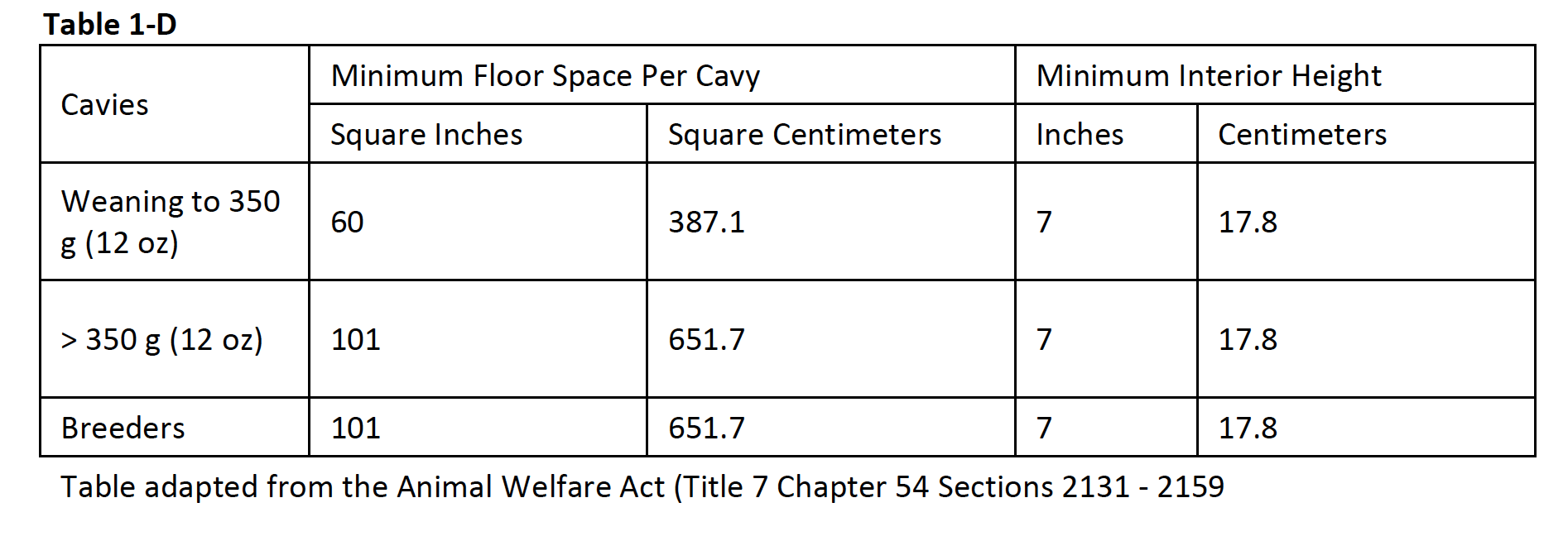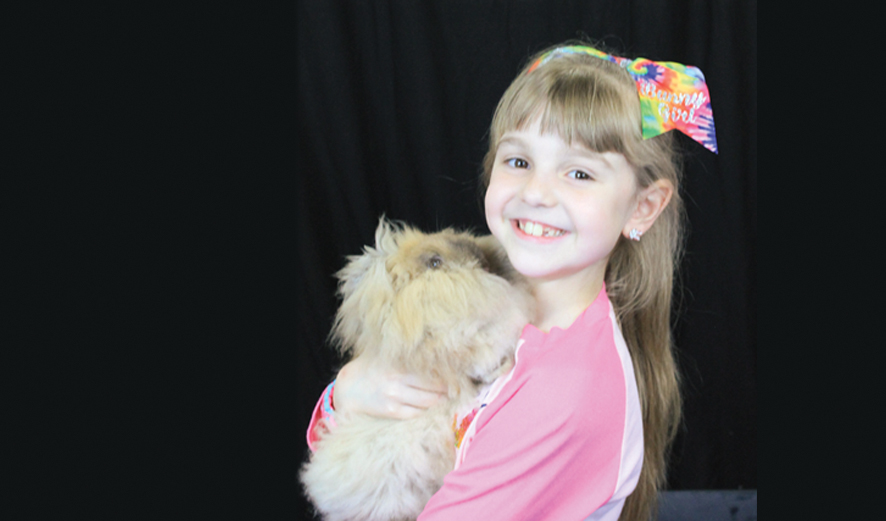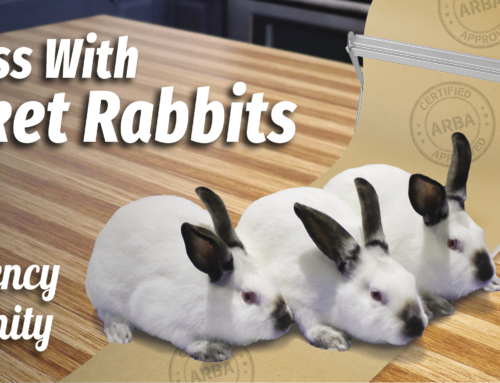This document is being created in order to provide guidance to all individuals who care for rabbits and cavies for the purposes of pets, show animals, commercial uses (i.e. food, fiber, and exhibition) and laboratory uses. This document is also meant to serve as a guide for individuals who serve in animal welfare and regulatory organizations. These recommendations provide a general guidance on the best practices in caring for rabbits and cavies. These recommendations are meant to work in conjunction with the Animal Welfare Act (AWA) giving more concrete definition to the AWA and are not meant to supersede the AWA for those who are bound to follow the AWA for regulatory compliance.
Section 1: Housing for Rabbits and Cavies
Cage Size
Rabbits and cavies need to be provided a cage of adequate size to accommodate species and breed specific behavior. Table 1-A provides minimum space requirements for one rabbit based upon the weight of the animal. Available cage space is calculated by multiplying the cage width by length and subtracting the space occupied by the feed and water dishes located on the floor of the cage. Feeders and waters fixed to the side of the cage, not coming in contact with the floor of the cage, need not be subtracted from available cage space.

Table 1-B lists the required minimum cage size according to the AWA by breeds based upon the breed’s maximum senior weight (animal at mature size) Individual animals may be housed in smaller cages based upon their weight. Table 1-C describes the minimum floor space per rabbit is met as required by individually weaned rabbits and the rabbits are compatible; however group housing is not ideal.


Cavies are to be housed in cages with the following minimum requirements as seen in Table 1-D based upon the animal’s weight. Cavies are frequently group housed so the minimums described would be for each individual animal within an enclosure.

Cage Construction and Environment
Cages are to be constructed in a manner which takes into account species and breed specific behaviors and needs, protect the animal from harm by predators, and protect the animal from injury. Any sharp edges are either to be dulled or covered with a material, such as a plastic guard, to prevent injury to the animal and owner. Cage components need to be replaced as they wear out to prevent safety hazards to the animal and its owner. Cages with either solid floors or a resting board, for those enclosures with wired bottoms, may need to be provided for those animals prone to sore hocks, particularly Belgian Hares, Flemish Giants and Rex based on the condition of the animal’s foot pads. Wire bottom cages are not recommended for cavies unless the floor is constructed in a manner that prevents the animal’s leg from becoming stuck, such as ½” by ½” wire.
It is strongly recommended that those breeds marked with an asterisk in Table 1-B be housed in cages with extra floor space and height due to the breed specific behaviors in these breeds of wanting to move about more than other breeds. If larger cages are unable to be accommodated for these breeds for whatever reason, it is recommended that an exercise program be incorporated into the weekly care regiment for these animals.
Animals who demonstrate stereotypic behavior, such as pacing back and forth; moving of feed and water dishes for no apparent reason; constant chewing at water bottles; pulling at wire; or any other repetitive behavior performed out of habit, are recommended to be given environmental enrichment. Toys such as golf balls or metal bells hanging in the cage encourage activity for those animals that require extra stimulation. PVC pipe is an excellent environmental enrichment device placed in cavy enclosures to help the animals with their natural burrowing instincts.
Cage Bedding
Typically, bedding is not used in wire bottom cages, but on some occasions, particularly on occasions of sudden extreme cold, either straw or hay may be used. Cages with solid bottoms will use wood shavings, wood chips, straw, etc. as contact bedding to help absorb urine within the enclosure. The size and type of wood shaving/chip needs to be taken into consideration in order to maintain healthy animals. Cedar chips should be avoided as it is known to cause upper respiratory issues in both cavies and rabbits.
Cage Cleaning and Sanitation
Cages need to be kept in a clean and sanitary condition in order to promote a healthy living environment for the animals. Bedding needs to be changes as often as necessary to prevent over soiling and wetness. For animals with contact bedding (bedding in which they come into direct contact), the bedding will typically need to be changed on a weekly basis at
minimum. Wire bottom floors need to be cleaned to remove any buildup of hair and fecal deposits. Trays are to be scraped, emptied, or flushed frequently to prevent buildup of waste. At no time should waste build up above the edges of the drop pan. For cages where waste drops to the ground, waste needs to be cleaned as often as necessary to prevent buildup of odor and moisture.
All cages need to be washed and sanitized with an appropriate sanitizing agent on a regular basis in or to kill bacteria, mold and viruses. Long haired breeds such as any Angora, American Fuzzy Lop and the Jersey Wooly are prone to have wool collect on the sides and bottoms of cages. Periodic power washing or torching the wool off the wire needs to occur to prevent wool from blocking waste from dropping through the wire. Calcium buildup from urine is normal and is to be expected to occur particularly on the bottoms of pans. Washing pans will help to slow this process. Periodic power washing will help to remove excess calcium scaling on pans, cages and cage supports. Commercially made products can be purchased that will help to eliminate calcium buildup on cage equipment.
Feed and Bedding Storage
Feed and bedding is to be stored in such a manner that it does not attract vermin such as mice and rats. Ideally open feed is stored in enclosed containers. Unopened feed bags need to be stored off the ground and away from walls. Bedding needs to be stored off the ground and away from walls.
Environmental Conditions
Environmental conditions (temperature, ventilation, and light) are important to maintaining healthy rabbits and cavies. The ideal environmental temperature range for a rabbit is 55˚ to 70˚ F. Rabbits can adapt to temperatures outside of this range with appropriate environmental conditioning. Many rabbitries are not climate controlled so animals may be subjected to environmental extremes. For these rabbitries, animals must be acclimated to the changes in temperatures. Rabbits do not do well when temperatures exceed 85˚F. Fans, misters, and frozen water bottles in cages are examples of methods to help animals cope with high temperatures. Ventilation during high temperatures is essential to help air quality; ventilation must be provided either by natural airflow and/or artificial airflow with the use of fans or air conditioners. Rabbits that are acclimated to cooler temperatures do quite well without the aid of warming agents so as heaters. Rabbits are quite hearty in cases of extreme cold, provided they have been acclimated to such temperatures. During cold weather months, animals may require more feed as more energy is used in cold temperatures. Rabbits need to be sheltered from the elements of direct sunlight, rain, snow, wind, etc. Natural outdoor lighting and light cycles are ideal environmental conditions. In cases where natural sunlight is not available artificial lights need to be provided in a cyclical fashion to mimic natural light/dark cycles.
Cavies are more sensitive to changes in environmental conditions and generally require stricter control. Ideally cavies are raised in a climate controlled environment. In cases where this is not possible, extreme cold and drafty conditions need to be avoided in addition to extreme heat. Ambient temperatures should fall between 60˚ to 85˚ F. Cavies do not do well in extreme heat. Direct sunlight exposure with no shading needs to be avoided. If cavies are raised outdoors, where high temperatures are possible, fans, ice bottles, or other cooling measures need to be utilized when temperatures rise above 85˚F. If appropriately acclimated, cavies can withstand temperatures below 60˚F provided they are protected from drafts and given sufficient bedding. Adequate light/dark cycles need to be provided such as 12 hours light and 12 hours dark, where natural light cycles are not available.
Section 2: Nutrition and Water
Proper nutrition is very important to raising healthy rabbits and cavies. It is recommended that that the primary source of nutrition comes from a commercially produced pelleted food. Consideration as to the breed, age, ideal weight, purpose of animal being raised (pet, show, breeding, meat, fiber, etc.) needs to be considered when choosing the pelleted feed. The milling date is located on the feed bag and feed should not be used if the feed is greater than six months old. Cavies require Vitamin C to prevent scurvy. If adequate amounts are not provided in the feed, it needs to be supplemented in the water or by other means.
Supplements such as hay, oats, sunflower seeds etc. may be given in addition to the pelleted feed. Treats, such as fruits and vegetables, may be given in small amounts as well. Treats and supplements should not be relied upon as a complete diet.
Feed is given in measured amounts to individual animals. The amount given per animal is based upon the breed, age, purpose, and desired weight of the animal. Measured amounts should be consumed in a timely fashion so the entire ration is used up within a few hours. It is recommended that animals be fed one ration once a day. It is not recommended that animals be fed free choice or have food in front of them at all times with the notable exceptions of nursing mothers or young, growing litters.
Clean potable water is essential to raising healthy animals and is to be freely given. Water should be checked daily or more frequently if conditions warrant (i.e. hot weather or extreme cold). If a watering system is utilized, water nozzles should be checked daily to ensure animals are receiving appropriate water flow.
Feeders and water receptacles (including watering systems) need to be periodically cleaned with an appropriate cleaning agent to reduce bacteria, mold, and algae buildup. Feed and water equipment also need to be inspected on a regular basis to make sure that they are free from any condition which would prevent the receptacles from being effective for holding feed and water or are a hazard to the animal or its owner.
Section 3: Breeding and Caring for Young
Rabbits reach sexual maturity between four to six months of age; however it is not necessarily recommended that they enter into a breeding program at this point. Rather it is recommended that animals enter into a breeding program based upon the relative size of a given breed. The ages are as follows: small breeds between 4 to 6 months, medium breeds between 6 to 8 months and large/giant breeds between 10 to 12 months of age.
Breeding needs to occur either in a neutral environment or by taking the doe to the buck’s cage. The gestation of a rabbit is typically 28-32 days. Nest boxes need to be offered to a doe minimally at day 28. The next box needs to be large enough to allow the doe to enter and turn around. Minimum cage sizes for does with litters are addressed in Tables 1-C. Once a doe has kindled she may be rebred as early as when the kits are two weeks old. If this intense system is used, kits are to be weaned at four weeks of age. Careful monitoring of the doe’s condition needs to be monitored for the health and wellbeing of the animal. While this intense breeding is acceptable, a less intensive breeding program is ideal. It is recommended that litters be weaned between 6 and 8 weeks of age for optimum growth. Animals need to be weaned before 10 weeks of age to prevent fighting. While it is recommended that litters be weaned into individual cages for optimum growth, litters may be group housed provided that the minimum cage space requirements per animal as described in Table 1-A and Table 1-B are met. It is recommended that does and bucks be housed in separate cages when group housing animals to prevent accidental breeding. The maximum number of litters that a doe may produce in a year is eight litters. This heavy breeding program is recommended primarily for commercial operations. The maximum amount of litters that the average breeding doe will produce in a year is five litters. Should a doe miss a breeding cycle or lose a litter she can be rebred immediately.
Cavies are able to be bred at a very young age of 2 ½ weeks; however, this is not recommended. Instead, it is recommended that boars enter a breeding program at five to six months old and sows at four months of age. It is recommended that if a sow is to be bred, her first breeding occurs before 7 months of age to prevent her pelvis from fusing making pregnancy dangerous for the sow. Cavies may be harem raised where one boar services up to four sows at once provided minimum space requirements are met as described in Table 1-D. Care needs to be taken to prevent breeding of young before the recommended age.
Section 4: Standard Operating Procedures
It is strongly encouraged that breeders document their specific care practices that they use for their animals in a set of Standard Operating Procedures (SOPs). These SOPs will provide any regulatory official a documented explanation and description as to the care, husbandry and breeding practices utilized for the animals on the premises. Information documented includes how much food is given, how often cages are cleaned, how cages are cleaned, how often sanitization and the method of sanitization used, etc. Documentation of SOPs will also help keep owners accountable to their own minimum care standards.





